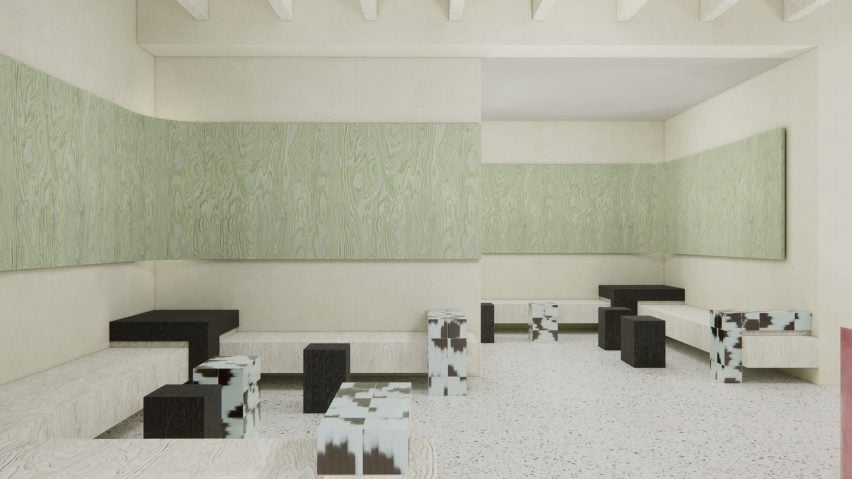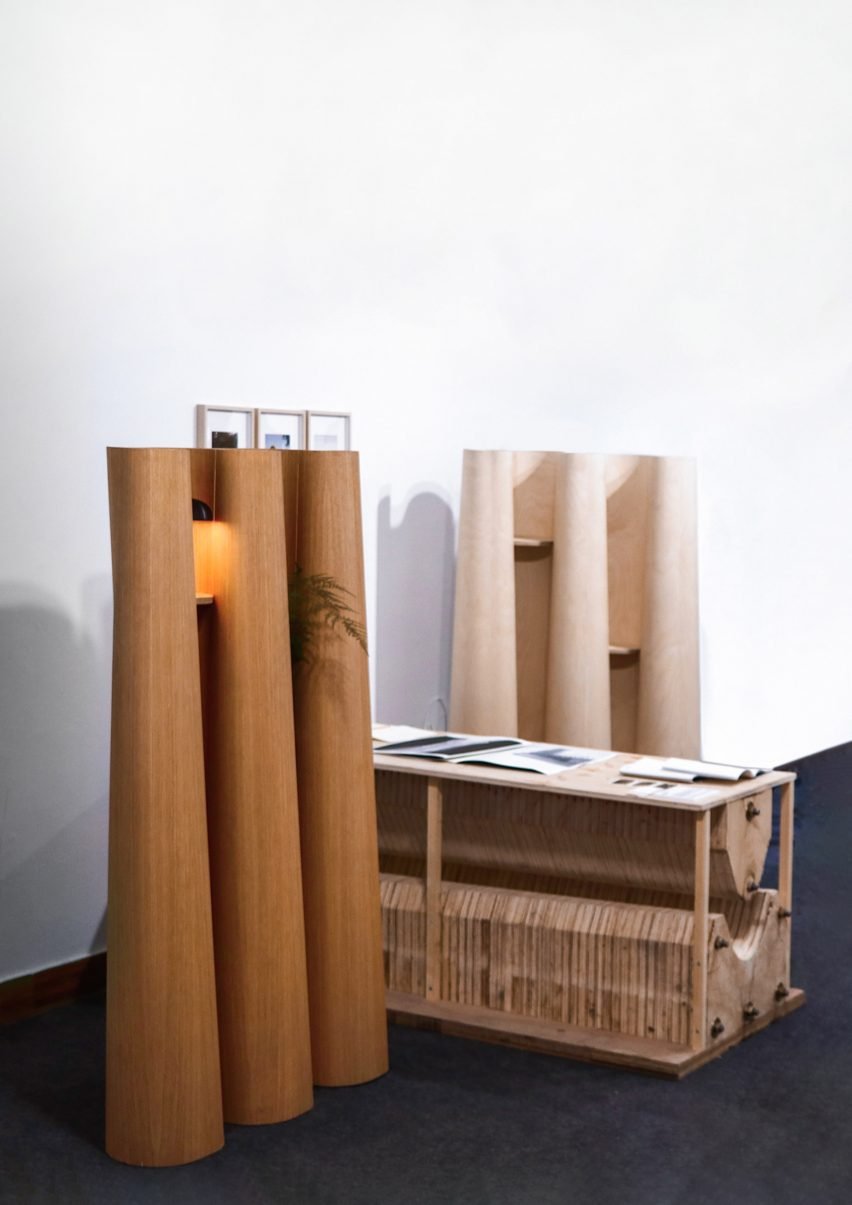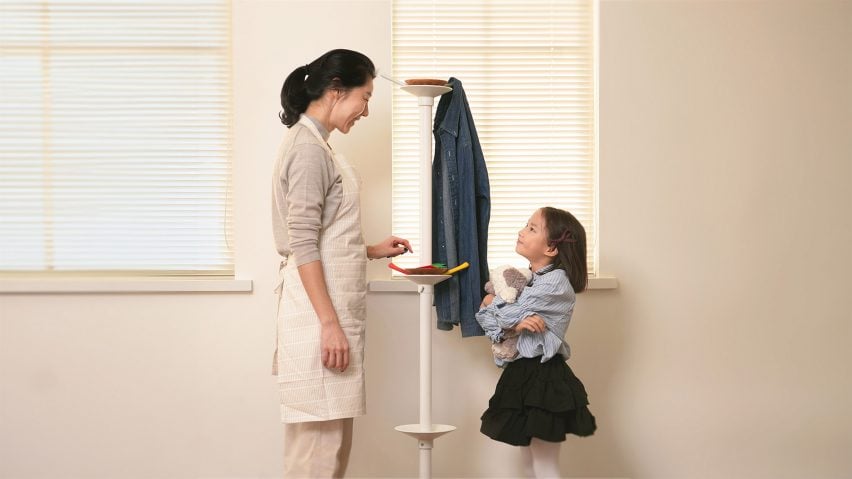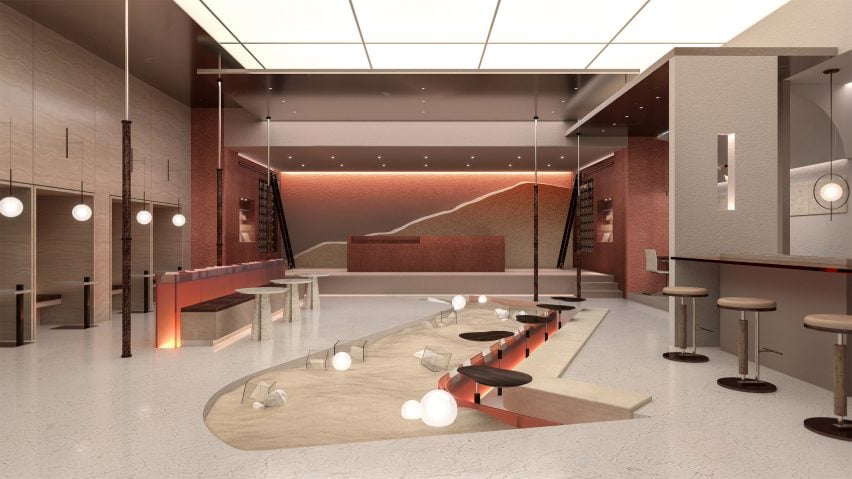
Hongik University presents ten industrial design projects
Dezeen School Shows: a fitness device which uses AI technology for virtual snowboarding is featured in Dezeen's latest school show by students at Hongik University.
Also included is a shelving system which relies on gravity and friction instead of regular fixtures and an interior with integrated sensory elements.
Hongik University
Institution: Hongik University
Course: BA Industrial Design
Tutors: Tate Eunyoung Kim, Dongkyun Lim, Ikseo Choi, Joo Yun Kim, Eddie Eoh, Kangee Lee and Sookyeon Kim
School statement:
"We nurture rational design thinking and creative abilities through an interdisciplinary approach to interpret, synthesise and solve problems in artificial environments, fostering designers who lead 21st-century trends and shape the future of design.
"Graduates push boundaries as professionals creating new values in human, technological and environmental contexts.
"They work in product, mobility, spatial and interaction design, contributing as designers and researchers in corporate design, mobility companies, advertising agencies, planning firms, broadcasting and exhibition design, driving innovation and competitiveness in modern industrial society.
"The 2024 Degree Show, themed 'New Normal', highlights the concept of 'Inside Beauty (內在美)'.
"This exhibition presents diverse projects that envision the future of product, spatial, mobility and interaction design, reflecting the department's dedication to pushing boundaries and advancing design disciplines."
Glide by Na Hyeon Kwon and Tae Rim Kim
"Glide is an innovative home fitness device powered by generative AI, offering a new dimension in snowboarding.
"Users can create their ideal snowy landscapes, interact with AI characters in real-time and experience snowboarding in a virtual world.
"Its auto-lacing system and intuitive bindings eliminate setup hassles, while haptic feedback from the shoe's vibration sensors vividly captures the feeling of smoothly sliding on snow and experiencing changes in terrain."
Students: Na Hyeon Kwon and Tae Rim Kim
Tutor: Tate Eunyoung Kim
Emails: nahyeonn18[at]gmail.com and xofla0213[at]gmail.com
movr by Jungmin Park and Chaewon Lee
"Movr redefines mobility as 'ro-bility', bridging movement and activity. It transitions seamlessly between robot and mobility modes, supporting users' lifestyles.
"Movr handles tasks like picking up or purchasing items, navigating autonomously using schedule and location data. Upon arrival, it transforms into mobility mode for transportation.
"With AI and ADAS, movr ensures safe, efficient driving."
Students: Jungmin Park and Chaewon Lee
Tutor: Tate Eunyoung Kim
Emails: pipi518[at]naver.com and cw222cw222[at]naver.com

Narrow by Changgeun Lee
"Natural fixation phenomena observed in daily life and nature caught my attention.
"Screws embedded in furniture appeared as artificial elements that did not align with the natural characteristics of the materials.
"This led to an exploration of fixation methods inspired by nature. The result is Narrow, a partition shelf designed using the principles of narrowing gaps.
"Instead of relying on hardware to secure it to walls or structures, it uses gravity and friction within confined spaces to stay in place.
"The more weight applied, the stronger the harmony between gravity and friction, ensuring the shelf firmly supports its contents."
Students: Changgeun Lee
Tutor: Dongkyun Lim
Emails: leeck0207[at]gmail.com

Ssok by Dayoung Sun and Jungwon Sohn
"Should all furniture inclusive of children be designed for kids?
"Ssok is a hanger for all family members, regardless of user.
"Hanger has two modules: the lower storage module for children under six and the stick module for older and parents.
"The inclined surface and bump on the stick module helps even young children to easily insert and safely fix the stick to hang clothes.
"Especially, children's stick modules have a height-adjustable structure according to growing height that allows them to organise by themselves.
"With Ssok, from childhood to adulthood, a special bond within the family is built over good times and memories."
Students: Dayoung Sun and Jungwon Sohn
Tutor: Dongkyun Lim
Emails: sdyoung990522[at]gmail.com and sohn2326[at]gmail.com

Desert Post by Jiseong An
"Desert Post, which follows the concept of a post office built in a desert, is a space that connects individuals who each carry their own solitude. In this space, you can choose a spot to focus, write a letter and freely exchange it with an anonymous recipient.
"These days, emotional isolation is widespread; everyone needs a quiet space to lay down their burdens without fear of judgment.
"Through an anonymous handwritten letter penpal service without a designated recipient, it dreams of offering a resting place for lonely hearts. May the deserts of everyone's lives no longer feel desolate."
Student: Jiseong An
Tutor: Ikseo Choi
Email: pantotherabbit[at]gmail.com
Coco-Zam by Jiyun Baek and Hyunseo Choi
"Coco-Zam is a brand of rest, sleep and dreams.
"Coco-Zam story analyses people's sleep and dreams and prescribes the rest module.
"The module connects the story and the brand space by installing in the actual brand space.
"In the brand space, you can experience various rest and sleep through modules, record and share dreams that you experience with sleep.
"Hope you have a deep night's sleep through quality rest in Coco-Zam. Co-co-good night!"
Students: Jiyun Baek and Hyunseo Choi
Tutor: Ikseo Choi
Emails: jyjyjyjy01[at]gmail.com and choihyunseo421[at]gmail.com
ākramaṇa by Yoon Ha Lee, Gayoung Yang and Yerin Jo
"ākramaṇa is a lifestyle brand inspired by Minjukim.
"It presents Korean aesthetics with a modern sensibility to present a new visual language.
"Guided by the themes of permeate and discover, it curates moments where traditional charm meets unexpected modernity.
"ākramaṇa shows signature 'Korish Style' that blends Korea's warmth with Danish minimalism, offering simplicity yet deep narratives."
Students: Yoon Ha Lee, Gayoung Yang and Yerin Jo
Tutor: Joo Yun Kim
Emails: ssyhsy3[at]naver.com, imygy9[at]gmail.com and yerinjo001110[at]gmail.com
Christine Project – The Tasting Room by Youjin Kim
"Christine Project – The Tasting Room is a branded space and store interior by the Korean handbag brand.
"Reflecting the creative sensibilities of its chef-turned-director, it establishes a spatial persona that deeply resonates with its target audience.
"The store interior design incorporates unexpected elements that broaden perspectives, encouraging frequent visits.
"The name The Tasting Room symbolises a multi-sensory experience where sound, sight, taste and content interact seamlessly, akin to the act of tasting a dish – immersing customers in the brand and its essence."
Student: Youjin Kim
Tutor: Joo Yun Kim
Email: uzismujin[at]gmail.com
Elemental by Seongho Lim
"Elemental is a mobility service that combines spaces and furniture, utilising robotics and automation technologies to help families venture into nature and create more meaningful lives and memories.
"By stepping beyond fixed living boundaries, families can explore the natural world while enjoying a harmonious balance of work and leisure at an expandable basecamp equipped with robots and automation.
"The family retreat in nature provided by Elemental is a special space that fosters warm moments and deep connections, delivering memories on an entirely new level."
Student: Seongho Lim
Tutor: Eddie Eoh
Email: seongho6570[at]gmail.com
Amulet by Myungeun Koh and Changjun Eun
"Amulet is an AI-powered service that turns aspirations into actionable goals, guiding users in daily life.
"For centuries, people have carried aspirations and wishes close to their hearts. Wish stones were rubbed or worn as necklaces, symbolising hope for their desires to come true in daily life.
"We have reinterpreted the concept of the wish stone for the modern era, transforming it into an AI module designed to assist users in achieving their goals.
"Personalised amulets connect goals to routines, with a context-responsive UI suggesting tailored schedules and tasks. The amulet adapts to progress, visually reflecting achievement and milestones and can integrate with calendars, offering actionable plans in health, self-growth, relationships and work.
"Amulet bridges aspirations and everyday life, offering a new path to a better future."
Students: Myungeun Koh and Changjun Eun
Tutors: Kangee Lee and Sookyeon Kim
Emails: monakoh0517[at]gmail.com and euncj3[at]gmail.com
Partnership content
This school show is a partnership between Dezeen and Hongik University. Find out more about Dezeen partnership content here.